
Calandrinia is a large genus of flowering plants known as purslanes and redmaids. It includes over 100 species of annual and perennial herbs which bear colorful flowers in shades of red to purple and white. Plants of this genus are native to Australia, western South America, Central America, and western North America. Some species have been introduced to parts of New Zealand, southern Africa, Asia, and Europe.

Dampiera is a genus of about 70 species of flowering plants in the family Goodeniaceae, all of which are endemic to Australia. Plants in the genus Dampiera are subshrubs or herbs with sessile leaves, flowers with five small sepals and blue, violet or pink, rarely white, two-lipped flowers.

Thryptomene is a genus of flowering plants in the family Myrtaceae and is endemic to Australia. Plants in the genus Thryptomene are shrubs with small leaves arranged in opposite pairs and white or pink flowers. About forty-seven species of Thryptomene, occurring in all Australian states and the Northern Territory, have been formally described.

Xanthosia is a genus of flowering plants in the family Apiaceae and is endemic to Australia. It comprises 20 species of shrubs endemic to Australia. Plants in the genus Xanthosia are perennial herbs or small shrubs, the leaves divided, toothed or lobed,, the flowers white, pinkish or pale green and usually arranged in a compound umbel.
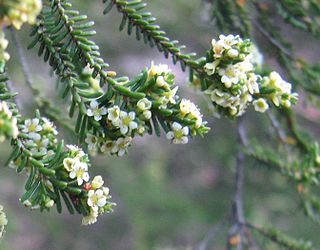
Micromyrtus is a genus of flowering plants in the family Myrtaceae and is endemic to Australia. Plants in the genus Micromyrtus are shrubs with simple leaves arranged in opposite pairs, and white, pink or yellow flowers arranged in upper leaf axils, the flowers with five sepals five petals and five or ten stamens.
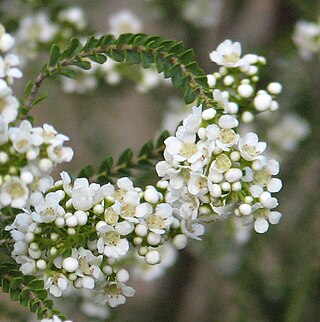
Scholtzia is a genus of flowering plants in the family Myrtaceae, which are endemic to the south-west of Western Australia. The genus was first described by Schauer in 1843, who named it in honour of the physician Heinrich Scholtz. The type species is Scholtzia obovata.
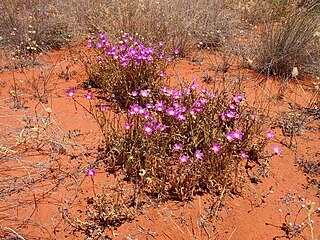
Rumicastrum balonense, synonym Calandrinia balonensis, is a succulent plant native to arid and semi-arid regions of Australia.

Chamaescilla is a genus of Australian herbs in the subfamily Hemerocallidoideae within the asphodel family. They have grass-like basal leaves and tuberous roots. The flowers have six petals and six stamens. The seed capsules contain black, glossy seeds.

Pelargonium australe is a perennial herb that is endemic to Australia, and found in all states except the Northern Territory. Common names include native storksbill, wild geranium and austral storksbill. The species grows to 50 cm high and has leaves with 5 to 7 lobes. Umbels of 4 to 12 flowers appear between October and March in the species' native range. These are pink with darker markings.

Nymphoides crenata, commonly known as wavy marshwort, is an aquatic perennial herb of the family Menyanthaceae endemic to Australia, found in all mainland states and the Northern Territory

Velleia paradoxa, or spur velleia, is a small, softly pubescent perennial herb in the family Goodeniaceae, endemic to Australia. It is found in South Australia, Tasmania, Victoria, New South Wales and southern Queensland. It grows in sclerophyll forest and grassland. It has oval to elliptical leaves which are from 7–25 centimetres (3–10 in) long and it flowers mainly from August to February.

Chenopodium spinescens is a species of plant in the family Amaranthaceae and is endemic to all mainland states and territories of Australia where it is known as Rhagodia spinescens.
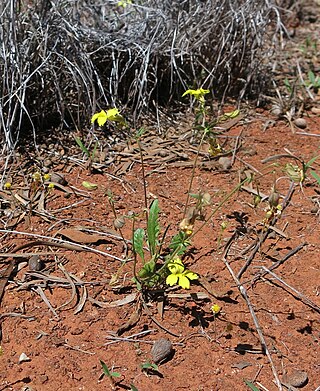
Velleia glabrata is an annual herb in the family Goodeniaceae, which is native to all mainland states and territories of Australia with the exception of Victoria. It grows on sand and clay, flowering from June to October.

Rumicastrum granuliferum is an annual herb in the family Montiaceae, and is native to New South Wales, Tasmania, Western Australia, South Australia, and Victoria.

Baeckea linifolia, commonly known as swamp baeckea, weeping baeckea or flax-leaf heath myrtle, is a species of flowering plant in the family Myrtaceae and is endemic to eastern Australia. It is an erect shrub with linear leaves and small white flowers with eight to fifteen stamens.

Tribulus macrocarpus is a species of flowering plant in the family Zygophyllaceae, which is found to the central north of Western Australia, and southern inland Northern Territory and northern South Australia.

Palaquium galactoxylum, commonly known as Cairns pencil cedar, Daintree maple or red silkwood, is a species of very large tree in the family Sapotaceae which is endemic to rainforests of New Guinea and northern Australia. It can produce spectacularly large buttress roots.
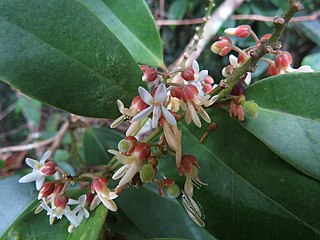
Xanthophyllum octandrum, commonly known as Macintyre's boxwood, false jitta, yellow boxwood or sovereignwood, is a slow-growing tree in the milkwort family Polygalaceae which has the potential to reach thousands of years of age. It is endemic to coastal northeastern Queensland, Australia.

Alpinia arctiflora, commonly known as the pleated ginger, is a plant in the ginger family Zingiberaceae which is endemic to northeastern Queensland.

Rumicastrum is a genus of plants in the family Montiaceae. It includes 66 species native to Australia, Tasmania, and New Guinea. These species were formerly classed in genus Calandrinia, which was discovered to be paraphyletic.




















